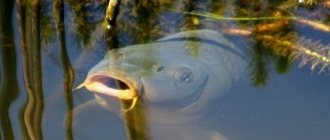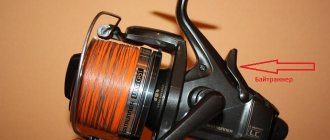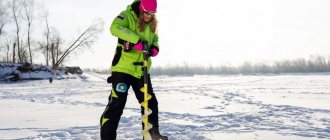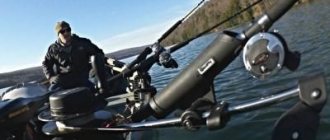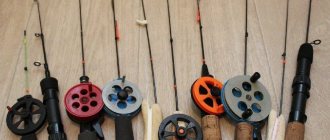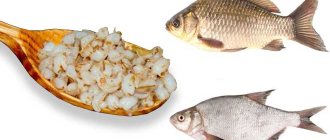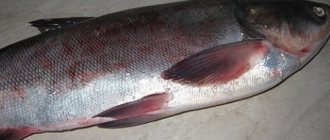Author of the article
Andrey Soprykin
Professional fisherman with 23 years of experience.
Articles written
85
There are many nuances and important details for successful carp fishing in the fall: bait, groundbait, choice of location, weather conditions. Any minor detail can become fatal, ruin your vacation and deprive you of a trophy. Let's take a closer look at how carp fishing works in the fall.
The autumn fish feast is a real haven for the fisherman. Carp also have such a period. You can catch this strong fish even in slow times, if you know where, how and what to fish for.
Best bite
Experienced carp anglers know that weather conditions, water temperature and wind direction play an important role in the choice of location, bait, bait and the outcome of the catch. All these factors must be taken into account when going carp fishing in the fall. A good bite will ensure knowledge of the habits and preferences of the fish, but there are, of course, exceptions and the obtained trophy cannot be called anything other than luck. The following patterns in the behavior of carp in autumn have been noted:
- bites at night, only after several warm days;
- in sunny weather it feeds in shallow water;
- In late autumn, activity subsides, biting only during the day.
Tactics: Fishing for Carp in Autumn
In the fall, it is important to lure carp correctly, not to overdo it with the attractant, and not to add extra granules. When fishing with a tube, you can throw a lot of boilies at the bait point. With this position you will keep the fish in the bite zone for a long time.
Remember that the main thing is accurate and long casting! The distance can be formed using the revolutions of the coil; it is advisable to know how many meters the coil winds in one revolution.
Then an elastic band is attached to the spool or secured in a clip, depending on what is convenient for you. In this simple way, we do not deviate from the fishing zone.
Carp does not like cloudy days and especially when it rains, but they simply love sunny weather with a light breeze. The best wind for carp is south and east and average atmospheric pressure.
When there is a change in the wind and a change in the bite, the carp categorically refuses to be caught, no matter what tricks you try. Mild weather is not typical for autumn, but it is better to choose sunny days for fishing.
When you go fishing for carp, take several sets of gear with you at once. Sometimes you have to wait for hours for a bite, and an extra rod only increases the chances of success.
This type of fishing is difficult because you have to look at the top of the feeder for a very long time and it gets tiring, but when a good carp sits on the hook, the fatigue goes away instantly.
Don’t forget about bait, you will need a lot of it, and you will also have to combine it with attractants and baits to achieve results.
Catching carp in the fall is very difficult, but when you begin to understand the intricacies of catching this fish, it will not cost you anything to catch a solid trophy, especially if you fish in the fall.
This article should not be taken as a direct guide to action, just try to find yourself in carp fishing!
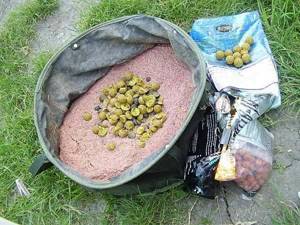
Advice from experienced people
Carp are successfully caught using float tackle when it comes to feed at the shore edge or at a long distance, it all depends on the chosen rod. But keep in mind that the fish is strong and not easy to get. The fishing rod must be equipped with a powerful reel and strong fishing line. To avoid unwanted trips, it is better to use braid and tie a leash.
Carp may be alarmed by floats, so when choosing, avoid bright colors. Stock up on bait; the place needs to be well fed in order to attract wary fish, especially trophy-sized ones, with its tasty smell. The prepared porridge or store-bought mixture should be formed into balls the size of a tennis ball with your hands and scattered around the perimeter of the intended fishing.

Don’t expect a bite right away; the carp will come as soon as it forgets the noise made during feeding. When biting, prepare for strong resistance, this will help you not lose your catch and prevent it from going into snags.
You can catch carp in spotted holes with a feeder. First you need to feed the fishing spot. To do this, make 5 - 10 casts of the feeder with treats. Try to hit more closely. Then change the feeder to a sinker so as not to scare the carp. And cast to the fed place. When everything calms down, the fish will come. Every month of autumn has its own subtleties and tricks.
Search for a Promising Place. Where to Look for Carp?
The ideal place for the feeder in the autumn will be a level table with a uniform decline in depth. It is there that somewhere in the depths there is a trophy carp and perhaps waiting for your bait.
You need to cast the bait exactly to the same place, plus or minus half a meter, and carefully soften the fall of the rig on the water by controlling the fishing line on the reels, when the bait almost enters the water, we should move the tip back a little, thereby the rig will absorb the splash It will turn out to be quiet and will not scare away cautious fish.
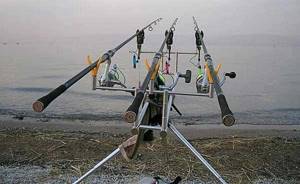
For comfortable fishing, you will need a comfortable platform with soft foam feeder stands and a standard landing net for carp fishing. It is advisable if the tip of the feeder is inclined towards the water, then we have a better chance of making a high-quality hook.
Catching carp in the fall with a specialized rod is practically not excluded, except that such sticks are used to catch fish in stocked reservoirs with a large concentration of large fish. Sometimes this pleasure is not cheap, but it’s worth a try.
A carp rod is a powerful thin blank with large guides and excellent sensors. Casting with such a rod is as far and accurate as possible.
If when fishing with a feeder you can use large-diameter monofilament lines, then here you can only use braided line, because we are talking about more significant trophies. During such fishing, the reel experiences simply enormous stress; most often, sizes 5000-6000 are used; it is desirable that a baitrunner system be present.
Oddly enough, they don’t catch fish with such gear using feeders. The starting feeding is done, the fishing point is designated, and then fishing is carried out from a small spot in the middle of the reservoir.
September
This period often brings joy with warm sunny days, during which carp readily feed. September is ideal for catching the desired trophy. When going fishing, take several types of bait mixture; when mixing, be sure to add an animal component. Maggots or bloodworms are suitable for this. In good September weather, carp readily bite on:
- corn;
- peas;
- barley;
- maggot;
- cheese;
- dough;
- boilies.
In September, carp are especially active early in the morning and at dawn.
October
With the onset of cyclones and the arrival of rains, tactics change. In natural reservoirs, carp switches to animal food, so it is better to use the following as bait:
- worm;
- bloodworm;
- maggot;
- crawling out;
- boilies with their aroma.
The only downside will be the little things eating the bait.
Expert opinion
Valery Andreevich Sizov
Professional fisherman with 35 years of experience
Important! A large bunch will scare away large prey in the fall. Place half a crawler or one small worm on the hook. Use smaller boilies (up to 15 mm).
Add an animal component or flavoring to the bait you will be fishing with.
Spring bait
It is best to make them yourself. It should be noted that spring bait has its own characteristics.
Let's list them:
- The bait must contain an alcohol-based flavoring;
- The balls for the mixture should be rolled so that they are very tight;
- It is important not to overfeed the fish, so five small balls will be enough;
- Regular fish food will not work here.
Carp tackle
Several types of gear are used to catch carp; they can be roughly divided into groups:
- float;
- bottom;
- feeder
Amateur fishermen and experienced carp anglers have different approaches to the selection of accessories. Much depends on the chosen reservoir and the size of the expected production. It is impossible to catch large carp with a regular fishing rod; simple gear simply cannot withstand the weight and resistance of the fish.
Float
Match rods are used for long casting.
Fly feathers - for fishing near the shore.
Plug-type ones are convenient for fishing on pay zones with a cultivated landscape.
Bolognese - on reservoirs with weak currents.
Bottom
The classic type of donkey is used in almost all reservoirs. The sinker is attached using a blind or sliding method. On reservoirs with a hard or slightly muddy bottom, feeders of the “nipple”, “plug” or spring type are used. To catch small carp in reservoirs with a clean bottom, it is possible to use so-called rubber bands.
Feeder
The classic feeder is used on all types of reservoirs. For carp fishing choose:
- a heavy class rod with a test weight above 70 g and a length of 3.80 - 4.20 m;
- the feeder should not be heavy, stock up on tips of different sensitivity;
- buy a powerful spinning reel with a rear clutch, the bullet of which holds 150 - 200 m of fishing line;
- choose a high-quality main line with a cross-section of 0.2 mm or braided line from 0.16 mm, don’t forget about the line for the leashes.
The choice of installation is an individual matter, some praise the “helicopter”, others – the Gardner loop, etc. There are no special requirements for installation for autumn carp fishing.
Expert opinion
Valery Andreevich Sizov
Professional fisherman with 35 years of experience
Important! Don't skimp on gear. Cheap Chinese lines and hooks are not suitable for carp fishing. Give preference to trusted manufacturers.
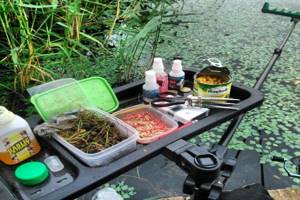
What to lure and feed with?
Carp is an omnivorous fish, it loves both plant and animal baits, the main thing is to know when to use which.
This is how they plant corn when fishing for carp
In the summer, baits of plant origin are more suitable:
- corn;
- peas;
- potato;
- bread, etc.
During the cold period, it begins to actively prepare for winter and gain fat, so it is better to use animal bait here:
- worm;
- maggots;
- bloodworm, etc.
Any grains, as well as flavorings and aromas are suitable for feeding. You can prepare the bait yourself from products that you can find in the kitchen, or you can buy it ready-made in a specialized store.
Lures and bait
Pay special attention to bait; the result of carp biting in the fall depends on the taste and smell of the prepared mixture.
Flavors
The bait in the fall should have an attractive aroma for carp; you can add fish oil or other oil to the porridge. Specialized stores have a wide range of products for these purposes, offering special attractants, mixes and additives.
Many fishermen use dips to attract carp. Before casting, the bait is treated or prescribed with a certain smell. Dip manufacturers claim that they use only natural ingredients. In cold water, these substances spread quite quickly and attract fish.
To increase the bite in the fall, you can take dips with the following scent:
- blood;
- shrimps;
- crab;
- worm;
- bloodworm.
In September, the aromas of garlic, dill, and hemp will be popular.
Expert opinion
Valery Andreevich Sizov
Professional fisherman with 35 years of experience
Important! Do not use several scents at once, this may alert the fish.
Lure
In the fall, the tastes of carp cannot be predicted, so when going fishing you need to prepare a multi-component mixture. It should include:
- grain crops, you can add corn, wheat, millet, etc.;
- powdered milk, cottage cheese, baked goods;
- worm, bloodworm, maggot;
- nuts;
- products that form a cloud, for example, breadcrumbs, cake.
In the first half of autumn, bait should consist of 5 - 10 components. After frost, carp are not active and do not move far from their chosen wintering place. It's much more difficult to catch him. Experienced carp anglers feed the selected area within 2-3 days before fishing. Sometimes this is the only way to lure out passive fish and provoke a bite. The bait should contain protein ingredients and have a strong strong odor, since aromas spread slowly in cold water. You can add fish or bone meal. In November, you should use a little more feed than in warm weather. When fishing with a feeder, try to place the food as densely as possible.
An exception to the choice of bait for carp are payers. It's much easier to fish there. You can find out in advance what is included in the autumn fish diet and use products familiar to carp; use the same principle for feeding, just reduce the amount. In stores, choose food only according to the season; in November, use special mixtures for cold water.
Expert opinion
Valery Andreevich Sizov
Professional fisherman with 35 years of experience
Important! Be sure to darken the bait. For this you can use black soil, cake or special dyes. In mid-autumn, carp are very shy and the bright color on the bottom can simply scare them away. When fishing with live bait, be sure to add it to the food so that the carp does not become suspicious of a lonely tasty treat.
Carp fishing in spring
In the spring, they go after carp after the reservoirs have thrown off their ice shell. This happens faster in rivers than in closed water areas. That’s why the bite starts a little earlier. If we speak in calendar terms, then the end of March is the start of carp fishing. A test of the pen, so to speak. Well, or a glass, whatever you like.
In carp, heat exchange processes occur less intensely than in roach or bream. Therefore, you can’t count on a good bite in the first half of spring. This is shown on the graph. If April is warm, flowers and leaves appear on the trees early, then the carp becomes more active, and every day they bite better on fishing rods.
Features of carp fishing in March, April and May
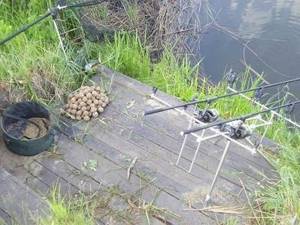
In spring, carp are very careful. He is scared off by extraneous noises and bright objects. During this time, silence must be observed. It comes closer to the shore in search of food, so it is better to catch it with float rods and Bolognese rods.
Carp spawn in May. During this period, it is caught using worms, maggots, corn and boilies. As the water warms up, it moves out to shallow areas. You can even catch it with a fly rod at this time.
As the water warms up, carp's sense of smell becomes more acute. In May, he can be tempted by sweet, fruity and chocolate aromas. But you need to use these scents wisely. If it’s already 20 degrees outside and the water is heated to 15 or higher, then you can use fruit dips, molasses, boilies, etc. He feeds especially greedily this month. Spawning is ahead, so a bucket of bait for a flock of hefty carp is not an excess, but the norm. It is enough to watch how these fish eat during underwater filming to understand: the one who will catch the carp is the one who feeds it well.
In the article fishing in spring
you can learn how to catch other fish at this time of year.
Go to the page features of catching carp in spring with float tackle
and get acquainted with this type of fishing with a rod.
Selecting a location
Study the topography of the selected body of water. Deep-water lakes do not warm up well even in summer. In September there is a good bite in shallow water. From mid-autumn, carp move to pits for wintering. A coastal echo sounder, marker rod or sounding rod will help you examine the bottom. Chat with local fishermen, maybe they will tell you about fishing spots.
Please note that carp does not like rotting algae and leaves and tries to keep their distance because the amount of oxygen is reduced and this negatively affects the carp’s appetite. At this time, he prefers a clean muddy bottom. If the reservoir is unfamiliar, try floating boilies as bait during this period.
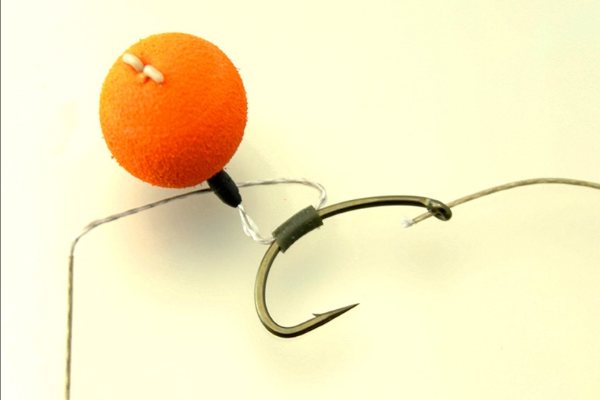
They do not lie on the bottom and do not absorb rotten odors. Use hair rigs for them, sucking in the boilie, the carp will inevitably sit on the hook.
Depending on the weather, the best places are:
- leeward coast, because there is more food brought by the wave;
- shallow water 1.5 - 2 meters, where the carp basks;
- pits;
- tables, that is, exits from pits;
- soil boundaries.
- carp often enter snags, bushes, etc.
Remember that a lot depends on the chosen reservoir, its depth, bottom, etc. It is impossible to give definite advice on where to bite.
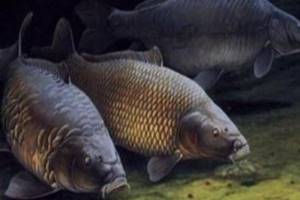
We recommend that you read additionally:
Fishing for carp in the fall requires preparation, knowledge and a certain amount of patience. This is an interesting and exciting pastime that often brings decent loot. And don’t forget to lay out the landing net in advance, because without it, when carp fishing, you will only be disappointed and annoyed. Now you know in some detail how carp fishing works in the fall, if you liked the article, leave a comment.
If you are interested in the best gear for carp fishing, you can check it out here.
How to catch carp in late autumn, in November
In late autumn the temperature is close to zero or negative, but there is no ice yet. How to catch carp in such conditions? Why do some famous anglers promote autumn carp fishing? In particular, they like the pre-winter time the most...
Carp is changing its lifestyle, where to look for it?
Summer carp sites become empty, but the fish do not disappear from the reservoir. It gathers in a limited space, forming winter huts, and leads a quiet lifestyle. It cannot behave differently, since in cold water all processes in the body slow down many times, the carp seems to fall into a half-asleep, feeds and moves occasionally.
- The life of carp in late autumn is built on the principle of energy conservation, with the goal of reaching warm water. Fish do not move throughout the reservoir, as in summer, in search of food. She eats only what is in the wintering place and on the few paths of its winter movement.
But if the fish feeds and moves along a certain route, then it can be caught. Two main questions remain: “Where to look for it?” and “When does he want to eat something?”
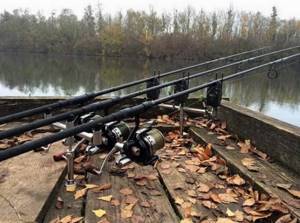
Various bodies of water
In late autumn, the behavior of carp in different reservoirs varies. In shallow reservoirs, the water temperature changes more strongly under the influence of the sun and wind than in deep places. This difference between reservoirs has a very significant effect on the life of carp.
- At depth, the water temperature is almost stable. Carp gathered in deep water are in a protective temperature shell and behave monotonously and lazily. There is nothing to change his behavior.
- In a shallow body of water, carp inevitably experience temperature changes. And the sun heating the water in the “swamp” activates the fish more than in a large reservoir.
Therefore, carp activity in such reservoirs is more likely on sunny, fine days, when by lunchtime the water temperature rises slightly, and the temperature in the stream flowing into a small reservoir also rises.
Where to go fishing in the fall
From the above we can conclude that for carp fishing in late autumn you should choose a shallow body of water.
- Fishing will be more interesting where there are no large deep waters, and the fish massively raise their mood as the water warms up on fine days.
But even in deep and large bodies of water, carp fishing cannot be called unsuccessful. Because in any ponds, the water temperature will not be the same in all places. There are warmer places, and there are areas of cold water. And on sunny days, fish also tend to gather in warmed shallow water, even if it is a very small area. The emergence of carp from the depths to the heated shallows occurs closer to lunch, and the fish moves to the depths in the evening, when the heating of the shallow water by the sun is completed and the water begins to cool due to contact with cold air.
Finding a warm area is always quite difficult, if not impossible. It’s good if the reservoir has already been studied like the back of your hand, and small areas are known.
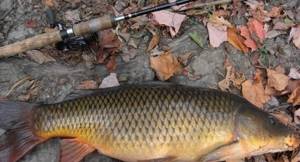
Where to throw the tackle
First of all, places located away from the shore, the so-called tables adjacent to the deep-water part, will be promising.
- It can be said that casting gear across shallow bays in the hope of getting into a lunchtime crowd of carp under the sun is unlikely to bring results.
Observing the water from above can help solve the problem. But this is possible if you are involved in ballooning, or if you climb leafless trees (if there are any near a body of water). Then there is a great chance to see carp with your own eyes on a sunny afternoon.
Warm wind also matters. If it is windy and warmer, and the air temperature exceeds the water temperature, then the wind will heat the water more than the sun, and besides, it will be driven towards the surf shore.
- A stable warm wind for several days can create a wonderful fishing spot near the surf shore.
The conclusion suggests itself - prepare your sleigh in the summer. You need to study the reservoirs in advance and note the plateaus that are not so interesting in the summer. But in late autumn these spots can be called hot spots.
Polluted places
In late autumn, you should in every possible way avoid places with organic remains of vegetation and leaves at the bottom of the reservoir. Usually, these are formerly very overgrown places, or coastal areas with trees bent over the water. The decay and rotting of organic residues take away oxygen and saturate the water with something unnecessary. Fish do not visit such places. Exceptions may be at the confluence of watercourses.
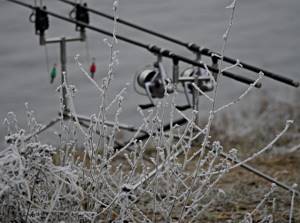
Confluence of streams
“November showed itself in all its glory with 7 degree frost with wind and snow. An ice crust formed under the shore. And it was necessary to go fishing for carp in such bad weather. There was nowhere to cast the fishing rod! Only at the confluence of the main river into the reservoir, among the dead reeds, did the bed of the main stream remain ice-free. It was in this place that the main events unfolded. At first the crucian carp was surprised; it took garlic bread and bloodworms. Then 2 boilies showed themselves, thrown strictly along the bed into the depth of the reservoir 40 meters from the place where the stream entered and the water surface began to expand. Excellent mirror - 5.5 kg and one gathering of more fish. »
There are no secrets here. In a stream, the water may be a little warmer, due to its heating by the sun, and there will also be more oxygen in it. The approach of fish to the mouth in late autumn is not uncommon.
Conclusion. If there is a good water supply with a shallow bay, then start examining the reservoir from here.
What to fish with
In late autumn, carp eat, but very little. He can't even eat much. Therefore, the strategy for feeding and supplying bait is based on a principle that is obvious in these conditions. You need to give the carp very little groundbait and bait so that it does not have time to overeat. But the food must be something that the carp cannot refuse.
If in summer even a well-fed carp will take any boilie, then in winter it can ignore the plant (for example, raspberry) smell. The example is, of course, far-fetched, but for sure, no one will doubt the correctness of the emphasis on animal odors. This food is more attractive for carp, even from the point of view of the same energy savings. At one time, getting the maximum kilocalories is the best choice.
Hence the conclusion, prepare animal ingredients and animal smells, the basis can be fish meal or cat food. If the bait has a vegetable scent, be sure to add a pinch of bloodworms to it. Prepare several different attachments (smells) at the same time and use them at a time in very small quantities.
The use of gear with a feeder is strictly prohibited. One single boilie on the hook and that’s it. As bait, a handful of balls the size of walnuts, but always finely divided food - more likely for the smell. You can use PVA bags to supply scented bait.
Carp fishing tactics
Is it worth using summer tactics in autumn and winter? Those. choose a place, feed, throw gear and wait indefinitely. Of course not. Fishing is only for a few hours. But a well-fed place is most likely not on a fishing trail at all, and you have to wait for carp there until the summer. In autumn fishing, the opposite is true. You yourself must look for fish, those places where they come out into the autumn sun. Therefore, if there is no bite, then it is better to re-throw the tackle to a new place every hour and no later. You can leave a couple of tackles in the most promising place in your opinion for the entire time, and feed it. But it is better to transfer the rest of the gear to the category of mobile ones, and move away from the camp or parking place with them as far as you consider possible. Fishing other noted promising places.
Generalizations
- Prepare meat dishes for carp, make several different smells.
- Choose a shallow body of water whenever possible.
- Try fishing at the mouth of the current at least once.
- Study the reservoir, look for fish coming ashore to bask.
- Use a very small amount of delicious, delicious bait.
- If you don’t find fish, throw them to different places and re-cast them more often. Don't stand still - you might freeze!
All you have to do is approach the whole process creatively and the autumn carp will not leave you. And further. It is important to monitor the weather forecast and not miss nice warm days. There aren't that many of them.
